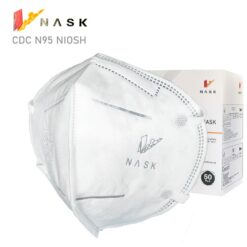The U. S. Food and Drug Administration (FDA) defines an N95 mask as a respiratory protective device that fits well on the face and can effectively filter airborne particles. N95 masks play an important role in controlling and blocking the spread of respiratory infectious diseases, as well as protecting the safety of medical staff. Several studies have shown that N95 masks are more suitable for medical staff to wear during the outbreak of respiratory infectious diseases. However, in the process of wearing N95 masks, it is prone to problems such as difficulty, pressure injury, headache, and increased facial heat , which affects the comfort of medical staff. At present, the research on the above problems at home and abroad mainly focuses on the pressure injury, and there are few other related researches. Therefore, this paper will summarize and analyze the main problems existing in the use of N95 masks, and then propose corresponding countermeasures, in order to provide a reference for subsequent research.
The main problems in the use of N95 masks
Difficulty breathing
Under high-intensity and high-load work pressure, medical staff wear N95 masks for a long time. Due to the large physical exertion, it will increase the breathing burden of the wearer, and may cause breathing difficulties due to hypoxia, resulting in physical discomfort.
The thicker the filter material of the mask, the greater the breathing resistance, which makes it more difficult for the mask wearer to breathe, and the more they feel chest tightness and shortness of breath.
Pressure injury
Medical staff wearing N95 masks for a long time can easily cause pressure injury to the nose and face, resulting in reduced wearing comfort for medical staff. Too tight straps, rough, hard, sharp skin contact parts, and small skin contact areas are all possible causes of pressure injuries in these areas.
Poor air tightness
The poor air tightness of N95 masks is one of the problems existing in the use of N95 masks. The reasons for the poor air tightness of N95 masks mainly include fixed specifications, incorrect wearing methods, excessive protection, physical activities, and insufficient operation training. Due to the fixed specifications of N95 masks, it is impossible to perfectly match each person’s face with the mask, resulting in insufficient face fit and poor air tightness, thereby reducing the protective performance.
Headache
Headaches caused by N95 masks affect the comfort of medical staff. Relevant studies have shown that during the epidemic of severe acute respiratory syndrome, the incidence of related headaches caused by the wearing of N95 masks by medical staff is as high as 37. 3%. Headaches are also medical care during the new crown pneumonia epidemic
A prominent symptom of a person wearing an N95 mask. Due to the need for self-protection, goggles are often required to be superimposed on a mask, and wearing it for a long time leads to hypoxia, and the elastic band of the mask tightens the head, causing headaches.
Facial heat rises
Wearing an N95 mask may affect the convection and skin evaporation processes, thereby affecting facial temperature regulation, which in turn negatively affects skin mechanisms , resulting in discomfort during use.
Solutions
1. Development of high-filtration and low-resistance masks
2. Use modified filter material. Modified filter materials, such as nanofibers and nanofiber meshes, are thin and breathable, and have good development prospects. Applying them to masks can improve the filtration efficiency of N95 masks against ultrafine particles such as viruses and other pathogens. First NIOSH N95 certified nanofiber respirator Nask SM-N9501 Nanofiber Smart Mask are tested and approved as one of most comfortable N95 mask. Available in n95instock.
3. take protective measures
A. Reduce pressure and increase contact area. Choose a suitable N95 mask, adjust it to a suitable tightness, and fix it properly to reduce the pressure of the N95 mask on the local area. You can choose an N95 mask with a slightly wider edge to increase the contact area of the N95 mask with the face.
B. Develop assessment tools and formulate risk management measures.
C. Use prophylactic dressings. It is recommended to use a thin foam dressing, which has good viscosity, good air permeability, and can ensure air tightness while decompressing. Appropriately cut the thin foam dressing before use, use tension-free paste, and stick it on the nose bridge, cheeks, forehead, and pinna vulnerable to pressure, and then wear an N95 mask.
D. Adjust the tightness of the mask. When wearing N95 masks, medical staff must adjust to an appropriate degree of tightness to prevent headaches caused by too tight elastic bands.





Thankyou so much. Im a doctor and I’m finding out new facts that would help me and my colleagues.